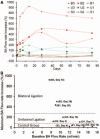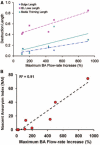Nascent aneurysm formation at the basilar terminus induced by hemodynamics
- PMID: 18451348
- PMCID: PMC2559803
- DOI: 10.1161/STROKEAHA.107.509422
Nascent aneurysm formation at the basilar terminus induced by hemodynamics
Abstract
Background and purpose: Hemodynamic insults at arterial bifurcations are hypothesized to play a key role in intracranial aneurysm formation. This study investigates aneurysm-initiating vascular responses at the rabbit basilar terminus subsequent to common carotid artery ligation.
Methods: Nine adult female New Zealand white rabbits were subjected to sham, unilateral, or bilateral common carotid artery ligation to produce varying degrees of compensatory basilar artery flow increase. Basilar artery flow velocity and geometry were monitored by transcranial Doppler and rotational angiography, respectively, for 12 weeks after surgery. Bifurcation tissues were harvested at 12 weeks and examined histologically. From the histological sections, we quantified the destructive structural changes at the basilar terminus and correlated them with the basilar artery flow rate increase.
Results: Subsequent to common carotid artery ligation, basilar artery flow rate increased by 105% to 900% at the maximum. All common carotid artery-ligated rabbits presented nascent aneurysm formation characterized by a bulge with thinned media and absent internal elastic lamina near the basilar terminus. We defined a nascent aneurysm index based on a multiplicative combination of the local destructive remodeling lengths measured at the nascent aneurysm. The nascent aneurysm index strongly correlated with the increase in basilar artery flow rate with R(2)=0.91.
Conclusions: Without other known predisposition, flow increase alone at the basilar bifurcation can lead to a nascent aneurysm. This nascent aneurysm formation is dose-dependent on basilar artery flow increase.
Figures




Similar articles
-
Characterization of critical hemodynamics contributing to aneurysmal remodeling at the basilar terminus in a rabbit model.Stroke. 2010 Aug;41(8):1774-82. doi: 10.1161/STROKEAHA.110.585992. Epub 2010 Jul 1. Stroke. 2010. PMID: 20595660 Free PMC article.
-
Experience with microaneurysm formation at the basilar terminus in the rabbit elastase aneurysm model.AJNR Am J Neuroradiol. 2010 Feb;31(2):300-3. doi: 10.3174/ajnr.A1823. Epub 2009 Oct 1. AJNR Am J Neuroradiol. 2010. PMID: 19797794 Free PMC article.
-
Assessment of Vascular Geometry for Bilateral Carotid Artery Ligation to Induce Early Basilar Terminus Aneurysmal Remodeling in Rats.Curr Neurovasc Res. 2016;13(1):82-92. doi: 10.2174/1567202612666151027143149. Curr Neurovasc Res. 2016. PMID: 26503026 Free PMC article.
-
Risk of aneurysm rupture at intracranial arterial bifurcations.Cerebrovasc Dis. 2010;30(1):29-35. doi: 10.1159/000313441. Epub 2010 Apr 27. Cerebrovasc Dis. 2010. PMID: 20424442 Review.
-
De novo large fusiform posterior circulation intracranial aneurysm presenting with subarachnoid hemorrhage 7 years after therapeutic internal carotid artery occlusion: case report and review of the literature.Neurosurgery. 2012 Sep;71(3):E764-71. doi: 10.1227/NEU.0b013e31825fd169. Neurosurgery. 2012. PMID: 22710380 Review.
Cited by
-
The quantitative comparison between high wall shear stress and high strain in the formation of paraclinoid aneurysms.Sci Rep. 2021 Apr 12;11(1):7947. doi: 10.1038/s41598-021-87126-w. Sci Rep. 2021. PMID: 33846487 Free PMC article.
-
A comparative review of the hemodynamics and pathogenesis of cerebral and abdominal aortic aneurysms: lessons to learn from each other.J Cerebrovasc Endovasc Neurosurg. 2014 Dec;16(4):335-49. doi: 10.7461/jcen.2014.16.4.335. Epub 2014 Dec 30. J Cerebrovasc Endovasc Neurosurg. 2014. PMID: 25599042 Free PMC article. Review.
-
Endogenous animal models of intracranial aneurysm development: a review.Neurosurg Rev. 2021 Oct;44(5):2545-2570. doi: 10.1007/s10143-021-01481-w. Epub 2021 Jan 26. Neurosurg Rev. 2021. PMID: 33501561 Free PMC article. Review.
-
Hypertension and Estrogen Deficiency Augment Aneurysmal Remodeling in the Rabbit Circle of Willis in Response to Carotid Ligation.Anat Rec (Hoboken). 2015 Nov;298(11):1903-10. doi: 10.1002/ar.23205. Epub 2015 Aug 21. Anat Rec (Hoboken). 2015. PMID: 26248728 Free PMC article.
-
Endothelial nitric oxide synthase and superoxide mediate hemodynamic initiation of intracranial aneurysms.PLoS One. 2014 Jul 3;9(7):e101721. doi: 10.1371/journal.pone.0101721. eCollection 2014. PLoS One. 2014. PMID: 24992254 Free PMC article.
References
-
- Hashimoto N, Handa H, Hazama F. Experimentally induced cerebral aneurysms in rats. Surg Neurol. 1978;10:3–8. - PubMed
-
- Hashimoto N, Handa H, Hazama F. Experimentally induced cerebral aneurysms in rats: part III. Pathology. Surg Neurol. 1979;11:299–304. - PubMed
-
- Hashimoto N, Handa H, Hazama F. Experimentally induced cerebral aneurysms in rats: part II. Surg Neurol. 1979;11:243–246. - PubMed
-
- Hashimoto N, Handa H, Nagata I, Hazama F. Experimentally induced cerebral aneurysms in rats: part V. Relation of hemodynamics in the circle of Willis to formation of aneurysms. Surg Neurol. 1980;13:41–45. - PubMed
-
- Hashimoto N, Kim C, Kikuchi H, Kojima M, Kang Y, Hazama F. Experimental induction of cerebral aneurysms in monkeys. J Neurosurg. 1987;67:903–905. - PubMed
Publication types
MeSH terms
Grants and funding
LinkOut - more resources
Full Text Sources
Medical

